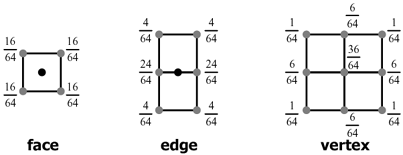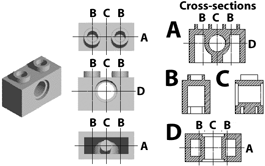|
Exercises for the second supervision
 The Doo-Sabin subdivision scheme is illustrated in SMEG, page 23, Figure 3. The Reif-Peters scheme
is illustrated in the diagram on the right. Reif-Peters uses a
different approach to Doo-Sabin: in it the new points are generated
halfway between existing points and connected up into a mesh as
illustrated in the diagram on the right (black: original mesh; grey: new
mesh). Note that (i) the existing points do not form part of the new
mesh and (ii) each new point's position is simply the average of the
positions of the two existing points at either end of the
corresponding line segment.
The Doo-Sabin subdivision scheme is illustrated in SMEG, page 23, Figure 3. The Reif-Peters scheme
is illustrated in the diagram on the right. Reif-Peters uses a
different approach to Doo-Sabin: in it the new points are generated
halfway between existing points and connected up into a mesh as
illustrated in the diagram on the right (black: original mesh; grey: new
mesh). Note that (i) the existing points do not form part of the new
mesh and (ii) each new point's position is simply the average of the
positions of the two existing points at either end of the
corresponding line segment.
(a) Doing the Reif-Peters
subdivision twice produces a mesh which looks similar to that produced
by doing the Doo-Sabin subdivision once (SMEG, page 23, Figure
3(left)). You can treat two steps of Reif-Peters as if it were a
single step of a Doo-Sabin-like subdivision scheme. Calculate the
weights on the original points for each new point after two steps of
Reif-Peters (i.e. work out what numbers replace those in SMEG Figure
3(right) for the Reif-Peters two step scheme). [2 marks]
(b) For the Reif-Peters one step scheme, explain what happens around
extraordinary vertices and what happens around extraordinary polygons,
giving examples. [2 marks]- [2003 P7 Q4 (c)] The Catmull-Clark bivariate subdivision
scheme is a bivariate generalisation of the univariate 1/8 [1, 4, 6,
4, 1] subdivision scheme. It creates new vertices as blends of old
vertices in the following ways:

(i) Provide similar diagrams for the bivariate generalisation of the univariate
four-point interpolating subdivision scheme 1/16 [-1, 0, 9, 16, 9, 0,-1].
[5 marks]
(ii) Explain what problems arise around extraordinary vertices (vertices of
valency other than four) for this bivariate interpolating scheme and
suggest a possible way of handling the creation of new edge vertices when
the old vertex at one end of the edge has a valency other than four.
[4 marks]
- There is a univariate binary C2 6-point subdivision scheme
which interpolates the original points and generates a new point between
every existing pair by:
P2in+1=Pin
P2i+1n+1=
a0Pi-2n +
a1Pi-1n +
a2Pin +
a3Pi+1n +
a4Pi+2n +
a5Pi+3n
There is also a univariate ternary C2 4-point subdivision scheme which interpolates the original points and generates two new points between every exisiting pair by:
P3in+1=Pin
P3i+1n+1=
c0Pi-1n +
c1Pin +
c2Pi+1n +
c3Pi+2n
P3i+2n+1=
c3Pi-1n +
c2Pin +
c1Pi+1n +
c0Pi+2n
The actual values of ai and ci need not concern
us for the purposes of this exercise.
(a) Given an initial set (n=0) with M points, how many floating point
operations (additions and multiplications) are required in the binary and
ternary cases to create the complete set of points for n=1? For both
binary and ternary, consider both the case of a closed curve and the
case of an open curve. (Notes: (1) in an open curve, we only generate
a new point if all the old points needed to calculate it actually
exist; (2) in a closed curve, the two ends of the curve join up and
where we need points which fall off the end of the sequence of points
we can simply loop round the indices by saying
Pin=Pi+Mn.) [4
marks]
(b) Both methods produce a C2 interpolating limit curve. We want to
compare the methods by producing refined sets of control points using
each of the two methods and compare the number of calculations
involved to see which is more efficient. Obviously we cannot get
exactly the same number of points in the refined sets [why not?]. So,
say we produce a refined set of points with (roughly) 8 times (binary) or 9
times (ternary) as many points as in the original, then which of the
two methods is more efficient in terms of number of floating point operations?
[2 marks]
(c) For large M, what factors other than number of floating point
operations will affect execution speed? How does execution speed depend on M? [3 marks]
- [2003 P9 Q6 (c)] Show how the following object can be
constructed using Constructive Solid Geometry (CSG). You may assume
the following primitives: sphere, cylinder, cone, torus, box. [You are
expected to describe which primitives are needed and how they are
combined but you are not expected to specify accurately all of the
parameters of the primitives.] [4 marks]

- [4C/3] List the three ways of combining objects using
constructive solid geometry (CSG). Describe how an object built using
CSG can be represented using a binary tree. Given the intersection
points of a ray with each primitive in the tree, explain how these
points are passed up the tree by each type of combination node to
produce a list of intersection points for the whole CSG object. [8
marks]
- [4D/4] The marching squares algorithm is a
two-dimensional version of marching cubes, where you generate line
segments in 2D rather than triangles in 3D. It could be used, for
example, where you have a regular grid of height values and want to
draw contours of constant height. Sketch an implementation of this
two-dimensional marching squares algorithm. [6 marks]
This exercise set is marked out of 40. This should take 72
minutes in an examination.
|